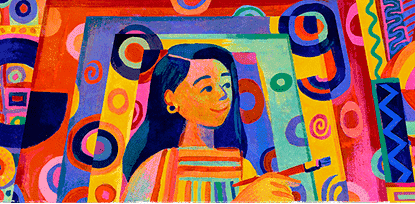[ad_1]
On Friday Google’s homepage pays tribute to the prolific Philippine artist and activist Pacita Abad, who on this day in 1984 became the first woman to receive the Philippines’s 10 Outstanding Young Men award. Her pioneering painting practice foregrounded overlooked women—Indigenous Filipina, domestic workers from Pakistan, Cambodian refugees. “I am a painter who paints from the gut, but has a strong social conscience, and my early work often dealt with global social issues,” Abad wrote in her artist statement. “I truly believe that, as an artist, I have a social responsibility for my painting, to try to make our world a little better.”
Abad was born in 1946 in Basco, in the northern province of Batanes, the Philippines. As a young woman, she studied political science at the University of the Philippines. Her political activism against the regime of Ferdinand Marco forced her to emigrate in 1970 to San Francisco, where she studied Asian history at the University of San Francisco and started painting among the city’s artistic community. It marked the beginning of a formative period of traveling as, art supplies in tow, she learned native techniques—and socio-politics—in locales ranging from Peru to Bangladesh. “Being a woman of color, I became more sensitive to the less than equal treatment of both women, and people with darker skin throughout the world,” she said.
Early paintings depicting tropical landscapes and primitive masks ceded to increasing abstraction. She also painted on a wide range of materials including metals, ceramics, glass, and bark. In her “trapunto” paintings, named after the Italian tradition of quilting, she stuffed unstretched canvases with cotton to create a sculptural effect. She then sewed onto their surfaces abstract assemblages of objects collected in her travels: blue tile from Iran, peacock feathers from Papua New Guinea, dyed yarn from India. A 1991 trapunto painting titled Caught at the Border depicts a migrant peering between the bars of a prison window. The prison facade is constructed from sequins and mirrors, reflecting the viewer’s gaze.
Upon her acceptance of the 10 Outstanding Young Men award, national newspapers published appeals from male artists to the award’s judges, demanding they reconsider a man for the honor. Abad, unruffled, later said that it was “long overdue that Filipina women were recognized, as the Philippines was full of outstanding women.”
Abad crafted more than 5,000 artworks over a 30-year career before her death in 2004. Her work has been featured in over 60 solo and group exhibitions at museums and galleries worldwide, and her art is held in private collections and cultural institutions in more than 70 countries.
[ad_2]
Source link


